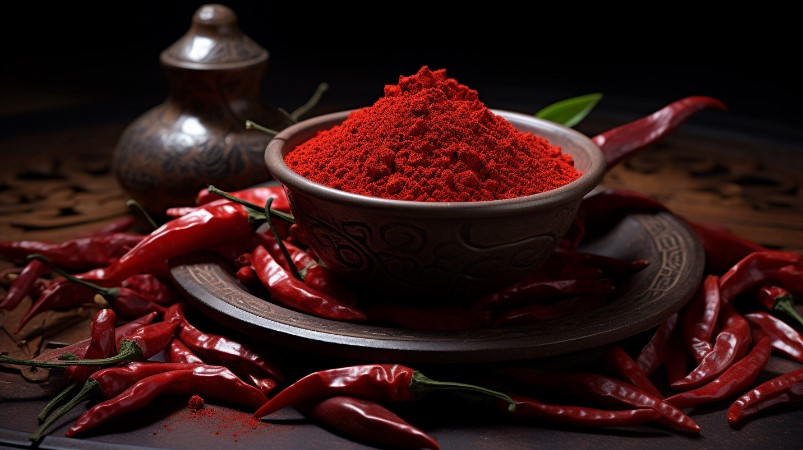Paprika

Capsicum red pigment, also known as capsicum red, is a tetraterpenoid orange-red pigment that exists in mature red pepper fruits, belonging to carotenoid pigments. Among them, the red group with greater polarity is divided into capsaicubin and capsaicubin, accounting for 50% to 60% of the total, and the other is the yellow component with less polarity, the main components are carotene and zeaxanthin, which have the activity of vitamin A.
Roter Farbstoff Capsicum is not only bright color, high color price, strong coloring power, good color preservation effect, widely used in pickled vegetables, convenient products, meat products, condiments, beverages, candy and so on. The shelf life of simulated food can be extended effectively. Moreover, it has high safety, nutritional health function, and has been proved by modern science to have anti-cancer, anti-radiation and other functions, and has a good development prospect.
Capsicum red pigment has been approved as a healthy and safe natural food additive by the United States FAO, the United Kingdom, Japan, EEC, WHO, China and other international organizations, and its international market is very tight.
Main component
The main color substance of capsicum is capsicum red pigment. Capsaicin is a carotenoid pigment present in capsicum, accounting for 0.2%-0.5% of the peel of capsicum. Foreign scholars have conducted in-depth and detailed research on the carotenoid pigment in pepper. More than 50 carotenoids have been isolated from capsicum, of which more than 30 have been identified. The research shows that the most important components of capsaicin are capsaicubin and capsaicubin. In general, capsicum red pigment (color value 10000 units) has the following average indicators: fatty acid 80%-85%, mainly composed of linoleic acid, oleic acid, palm acid, stearic acid, myristic acid; Vitamin E 0.6%-1.0%; Vitamin C 0.2% to 1.1%; Protein (total nitrogen) 140-170mg /l00g sample; Carotenoid 11.2% to 15.5%, mainly composed of capsaicubin, capsaicubin, R-carotene, lutein, zeaxanthin, cryptoxanthin, etc., of which capsaicubin and capsaicubin accounted for 50% to 60% of the total.
The contents of carotenoids in ripe fruits of different varieties of capsicum varied greatly, and the total amount of carotenoids, the content of red carotenoids (capsaicin, capsaicubin) and the content of chlorophyll in fruits of different ripening stages had great changes. From early fruit to full ripening, total carotenoids and red carotenoids increased 66 124-fold, respectively, while chlorophyll content approached zero at ripening, and the ratio of red to yellow increased from 0.22 to 1.34. Therefore, the ripe red pepper fruit is often used to extract the red pepper pigment.
Paprika
Capsaicin in capsaicin pepper has physiological functions such as analgesic, anti-itch, anti-inflammatory, antibacterial, lipid peroxidation regulation, myocardial protection, weight loss, and durable strong anti-inflammatory and analgesic effects, and has been widely used in processing, food and beverage, pharmaceutical industry, feed and other fields. Using red pepper as raw material, not only can high value-added capsaicin (40,000 yuan /kg) and many by-products be extracted, but the remaining residue after extraction can be reused as animal feed or deep processing raw materials. Therefore, the comprehensive development and utilization of pepper can produce huge economic and social benefits. Capsaicin is a mixture, which has been determined to have 19 components, of which capsaicin, dihydrocapsaicin and other 5 components have the highest content, the sum of which accounts for about 99% of the total, and the 5 compounds with capsaicin (accounting for 69% of the total), dihydrocapsaicin (accounting for 22% of the total) content is high, the sum of the two accounted for 91% of the total.
Basic property
Capsicum red is a deep red viscous liquid, paste or powder, insoluble in water, soluble in oil and ethanol, emulsifying and dispersibility, heat resistance, acid resistance are good, light resistance is slightly poor, strong coloring power. When iron, copper and other metal ions fade, when lead ions precipitate. In addition, this product can also be made in foreign countries with a certain spicy variety for food color, seasoning.
Application status of food industry
When used in beverages, jelly, soy sauce and sugar and other foods, capsicum red pigment not only has no toxic side effects on the human body, but also can increase the carotenoid compounds in the human body, and has certain nutritional value. When used, it is characterized by uniform coloring, stable nature, bright color, good brightness, and has broad application prospects in the food industry, especially in soy sauce and other foods. Studies have shown that the color effect of capsicum red pigment in food is good, and there is almost no floating stratification on the surface after three months. In addition, Japan and China have developed capsicum pigment preparations for beverages with good stability and excellent coloring effect, convenient manufacturing and no need for additives. Chili red pigment is used in simulated food, its stability, light resistance, heat resistance, acid and alkali resistance can better solve the problem of fading in simulated food processing, effectively extend the shelf life of food, and a wide range of sources, cheap price, is an ideal edible natural color in simulated food. The application of capsicum red pigment in pudding ice cream and yogurt showed that the color of the food did not change significantly with time, indicating that the pigment had a good performance in these two foods.
Roter Farbstoff Capsicum Anbieter: www.backvita.com
E-Mail: [email protected]
Telefon: +86 (029) 8187 2325
